The Tyrrell P34 Six Wheeler Suspension and front drivetrain
At the rear, suspension is very smart and easy to understand: it doesn't exist. It could be considered that the minimum service could be provided by the chassis natural flexibility... well, not, it was never designed to flex in any way.
In fact, the whole chassis suspension comes out from th front drivetrain. All the steering system is mounted on a metal deck that is fixed onto the main chassis plate. The steering deck fixation includes to springs at the front in order for the steering deck to oscillate sideways. In addition, the steering deck and the main chassis frame remain independent which lets them also move longitudinally.
Front drivetrain suspension
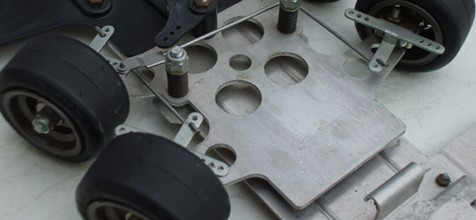
Suspension at work
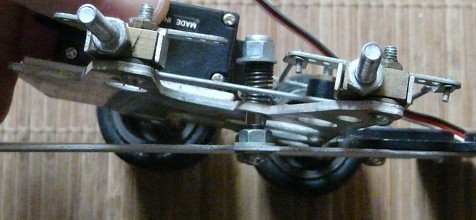
The way all this works is basic: everything works using a front unique pivot that uses the front drivetrain like a support for the entire chassis. Stiffness can be setup by compressing the springs. In theory, this system should make the chassis oversteer since the front drivetrain is kept in contact with the ground. In practice, all the weight is at the rear of the chassis and the very small front wheels offer little grip (even being 4): the truth is that this is a chassis with a lot of understeer. I will test the front drivetrain by making it stiffer or looser to see if it changes anything in the overall chassis handling.
Now let's go back to the steering itself: it uses quite a complex system due to the 4 front wheels.
The original steering system
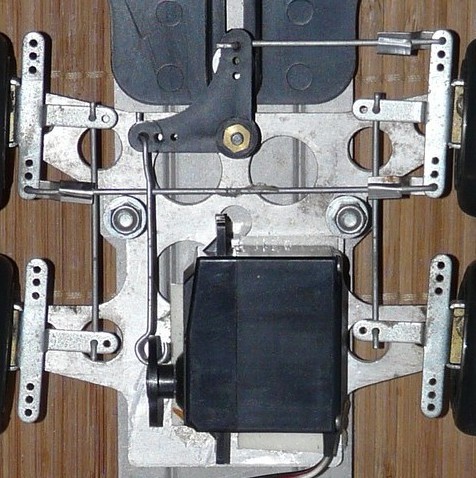
The modern steering system
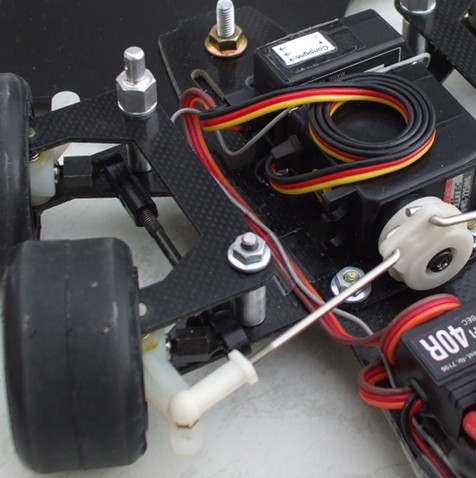
On the original version, the steering servo is double-sided taped on its side onto the steering deck. A link moves bracket located at the front of the steering system. This bracket transforms the steering servo longitudinal movement into a lateral movement towards the front right wheel. This wheel then drives the opposite front left wheel thanks to a link going transversally across the chassis. On both sides of the chassis, each pair of wheels are attached together by links in order to drive the second set of wheels.
This steering system is very complex due to the horizontally mounted steering servo that can't stand due to the lack of clearance under the body nose. If the servo could have been mounted like on the modern version, the steering system would have been much simpler. Most of all, the steering would have tremendously gained precision thanks to less linkage between the different elements. Unfortunately, the suspension pivots do not leave room for this: at the time, technology probably didn't let Tamiya designers integrate the suspension directly into the uprights like they do on modern Formula 1 chassis.
Explaining the original steering complexity and play was not innocent: as you can see on the photos below, the steering is somewhat elastic and with a variable geometry ![]() . Please note that the servo head remained fixed between the two shots:
. Please note that the servo head remained fixed between the two shots:
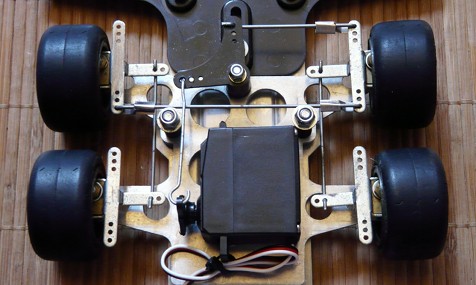
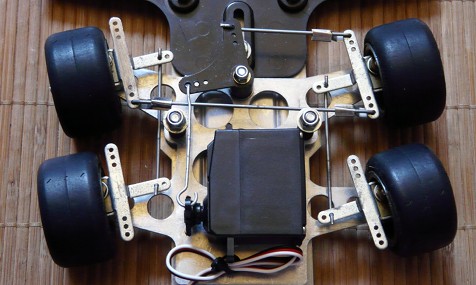
With so much precision in the steering system, racing lines are obviously... vintage ![]() . Well, the Tyrrell P34 is a Formula 1 and therefor should be the very best of the technology at the time, but Tamiya replica clearly doesn't show the same degree of sophistication. But we have to keep in mind that this model is over 30 years old and that it was only the third model released by the manufacturer: the mechanical challenge of the 4 wheel steering was not that easy to solve for the designers. Anyway, this is an old RC grand'ma from which you can't expect performances to be compared to modern models. At the time, RC models were mostly models in motion as the highly detailed bodyshell proves.
. Well, the Tyrrell P34 is a Formula 1 and therefor should be the very best of the technology at the time, but Tamiya replica clearly doesn't show the same degree of sophistication. But we have to keep in mind that this model is over 30 years old and that it was only the third model released by the manufacturer: the mechanical challenge of the 4 wheel steering was not that easy to solve for the designers. Anyway, this is an old RC grand'ma from which you can't expect performances to be compared to modern models. At the time, RC models were mostly models in motion as the highly detailed bodyshell proves.
The Tyrrell P34 6 wheels
On my model, the rims show some impacts, but nothing serious. On the other hand, the tires show cracks and were glued the wrong way on the rims which makes them impossible to tire-lettering. Even if my Tyrrell P34 could safely run with its original shoes, I preferred to get a complete set of new wheels. These parts are available and easy to find since the new modified F103RS chassis version wheelset is compatible with the original chassis.
The complete rim set (ref 9334060), the front (ref 9805718) and rear (ref 9805717) tires

Most of all, I wanted to have these parts in stock while they are still available and at reasonable prices since the 2000 re-release. Since my Tyrrell P34 will be run, it's better to anticipate tomorrow needs. Just one detail though: the original rims color is slightly different from the re-released ones. The dark gray from 1977 became black in 2000, but you'd better have a very close look to notice.
For tire-lettering, I used a know technique but it was the very first time I tried it: take a tooth-pick or a match and use them to place little paint drops into the letters drawings on the tire. The paint being liquid, it will naturally spread into the drawings. This sounds very easy but the art is to find the correct paint drop size. This requires a very close attention and to go very slowly: I spent a full day to paint the whole wheelset both sides.
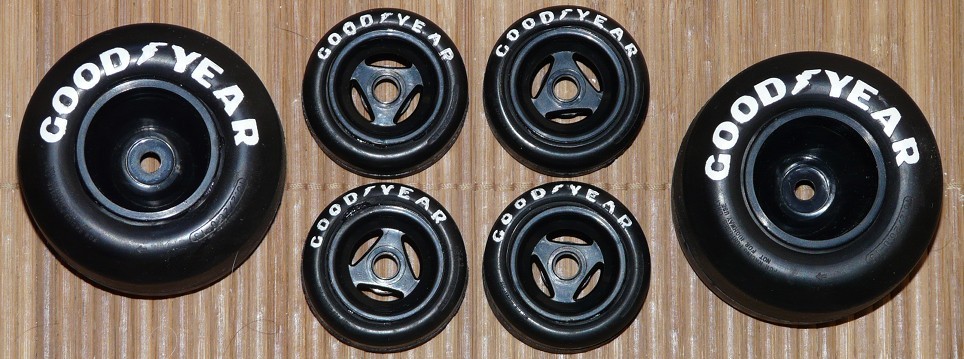
If the result is pretty good on the rear tires, it is perfectible on the much smaller front tires. For a first try, I'm pretty happy with the result especially since the defaults can't be seen when the car runs.
But adapting re-released front wheels is not a direct fit: on the original version, the wheel axle is a long 4mm screw on which a flanged tube is used as "flanged bearing" for the rim. A nut without screw thread goes into the rim and spins around the flanged tube (see the second photo below).
On the re-released version, you have real modern 5mm wheel axles (see first picture below)). The modern rims need 850 type ball bearings to fit the wheel axle.
To fit re-released rims on the 1977 original setup, you need 840 type bearings even if they are not the exact same dimensions: an 840 type bearing has an inner 4mm diameter, an outer 8mm diameter and a 3mm thickness. Since 2 bearings are required per wheel, this setup will result in a 1mm positive offset. The wheel axle screw being long enough, this will be no problem.
Re-released modern front uprights
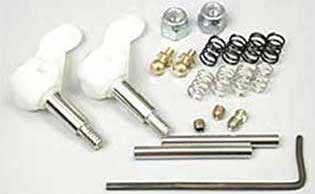
The 1977 original setup
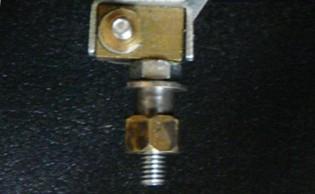
The 840 bearings for modern rims
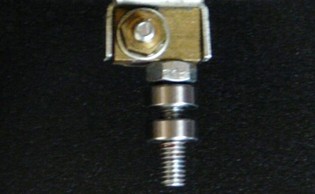
In the end, I will run my Tyrrell P34 with its original rim set and a new complete tire set, the re-released wheel set being kept as spare.




